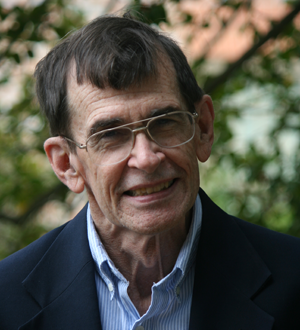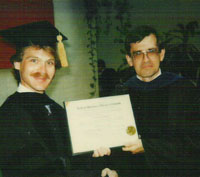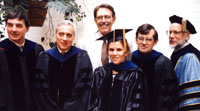Professor Robert Noonan: A history of firsts in computer science
 Take a look at the progression of technology over the past 36 years, and you'll see Computer Science professor Robert Noonan there every step of the way.
Take a look at the progression of technology over the past 36 years, and you'll see Computer Science professor Robert Noonan there every step of the way.
“When I arrived on campus in 1976, the College had just purchased an IBM mainframe System/370 Model 158,” says Noonan. “It was the latest technology of the time with two megabytes of memory, and it took up a third of the basement of Jones Hall.”
How times have changed.
“I now have more computing power in my office than existed on the whole campus when I got here,” says Noonan. Across decades of changing computing technology, one constant has remained—Noonan’s passion for staying on the leading edge of computer science.
“I discovered computers during my junior year at Providence College and realized that computers were just applied math,” says Noonan. After graduating in 1966 with a B.S. in mathematics, Noonan continued on to graduate school and earned his Ph.D. in 1971 from Purdue University, one of only five schools offering a computer science doctorate program at the time.
“Bob saw the future,” says Noonan’s wife, Computer Science professor Debbie Noonan. “As a young person, he saw the potential, before computers were even a household word. He saw what was happening and where it was going. He taught himself each new technology so he could teach others.”
“If you teach Shakespeare, it doesn’t change. There are new interpretations, but the core content doesn’t change. In this field, you are teaching yourself all the time, and Bob is constantly on the edge of technology.”
- Professor Debbie Noonan
After five years as an assistant professor at the University of Maryland College Park, Noonan came to William and Mary in 1976 as an associate professor and continued blazing down the technology trail.
By the late 1970s, Noonan was also working with NASA to create a "parser generator," a software program that helps computers talk to each other by translating a computer language into another program. It was a revolutionary project for that time.
In the mid-1980s, before Windows and Microsoft Word, Noonan wrote WMED, the first “what you see is what you get” computer editor software used on campus. Noonan paid students a dollar if they uncovered a bug or error while using the program.
“Bob is constantly writing new programs and codes,” says Debbie Noonan. “If he needed to move a student list from one document to another, rather than retype the names he would write a piece of code to move the list.”
In 1984, the Computer Science program officially became an independent department after an amicable split from Mathematics. Noonan was advisor to the College’s first computer science Ph.D. student, Randall Meyer, who graduated in 1988.
 “Bob's influence as a teacher, mentor, and friend guided the path of my research and my career,” says Meyer, now a software development engineer with Convey Computer Corporation. “He enjoyed his work, and that was evident in his concern and respect for his students. His enthusiasm, dedication, and pleasant attitude were a constant, whether presenting a lecture on Programming Languages or Compiler Theory, hacking out the next feature of his editor program, reviewing the seventh draft of a Ph.D. dissertation, or playing volleyball and flipping burgers at a Friday afternoon picnic at Lake Matoaka.”
“Bob's influence as a teacher, mentor, and friend guided the path of my research and my career,” says Meyer, now a software development engineer with Convey Computer Corporation. “He enjoyed his work, and that was evident in his concern and respect for his students. His enthusiasm, dedication, and pleasant attitude were a constant, whether presenting a lecture on Programming Languages or Compiler Theory, hacking out the next feature of his editor program, reviewing the seventh draft of a Ph.D. dissertation, or playing volleyball and flipping burgers at a Friday afternoon picnic at Lake Matoaka.”
Noonan’s drive for innovation also led him to select “wm” as the College’s domain name in 1988, well before the Internet as we know it today. He needed a domain name in order to connect the College with other research universities and Jefferson Labs via a network set up by the National Science Foundation. At the time, the Computer Science Department had the only domain server on campus on a dial-up network.
That same year, Noonan and a colleague wrote the College’s original computer lab manual, which is still updated and in use today. Twenty-three years later, the manual is on the fourth programming language, from Pascal to C++ to Java and now Python. Over the years, Noonan estimates that he’s learned upwards of 30 computer languages.
In the mid-1990s, Noonan was appointed Acting Associate Provost for Information Technology for two years. In that role, he was instrumental in getting the campus wired for the Internet. It was a time that his wife jokes about as “very painful,” because Noonan had to buy suits and wear ties in his administrative position. Noonan also served as the Computer Science department’s acting chair in 1984 and 1994-95.
 By the late 1990s, student enrollments in computer science skyrocketed as interest in technology grew, fed by the .com bubble. Ever the innovator, Noonan began to develop classes to teach students how to create behind-the-scenes data collection and processing for websites. The classes filled immediately.
By the late 1990s, student enrollments in computer science skyrocketed as interest in technology grew, fed by the .com bubble. Ever the innovator, Noonan began to develop classes to teach students how to create behind-the-scenes data collection and processing for websites. The classes filled immediately.
Soon after, Noonan and colleague Allen Tucker wrote Programming Languages: Principles and Paradigms, a text book focused on language design principles and the major programming paradigms. A second edition was released in 2006, and the text was released in Korean in 2007.
text was released in Korean in 2007.
“There are not words enough to adequately express Bob's role as a mentor and friend,” says Noonan’s doctoral student Laurie Smith King, Ph.D. ’92, now Associate Professor of Computer Science at College of the Holy Cross. “When I faced any obstacle or setback, Bob was always there with support, encouragement, ideas, and most importantly a calming manner that gave me confidence that I would prevail.”














